Product Images Xarelto
View Photos of Packaging, Labels & Appearance
- Label Image - lbl500904469
- Figure 1 - xarelto 01
- Figure 2 - xarelto 02
- Chemical Structure - xarelto 03
- Figure 3 - xarelto 04
- Figure 4 - xarelto 05
- Figure 5 - xarelto 06
- Figure 6 - xarelto 07
- Figure 7 - xarelto 08
- Figure 8 - xarelto 09
- Figure 9 - xarelto 10
- Figure 10 - xarelto 11
- Figure 11 - xarelto 12
Product Label Images
The following 13 images provide visual information about the product associated with Xarelto NDC 50090-4469 by A-s Medication Solutions, such as packaging, labeling, and the appearance of the drug itself. This resource could be helpful for medical professionals, pharmacists, and patients seeking to verify medication information and ensure they have the correct product.
Figure 1 - xarelto 01
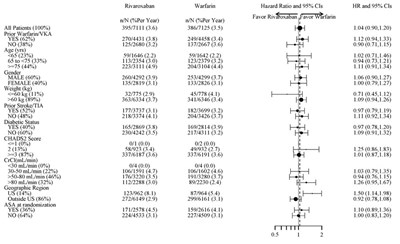
This appears to be a table with statistical results related to a comparison between the medications ivaroxaban and warfarin on various patient demographics and medical conditions. It includes hazard ratios, confidence intervals, and percentage of patients experiencing events per year.*
Figure 2 - xarelto 02
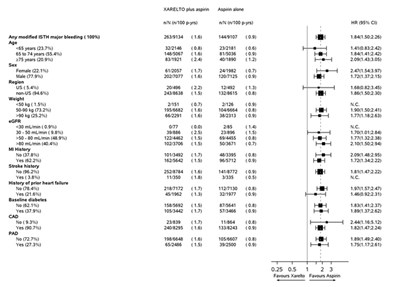
The text is presenting data about the incidence of bleeding events and demographic and medical characteristics in a study that compared the use of XARELTO plus aspirin to aspirin alone. Information about age, sex, weight, region, and medical history is presented, among other variables.*
Figure 3 - xarelto 04
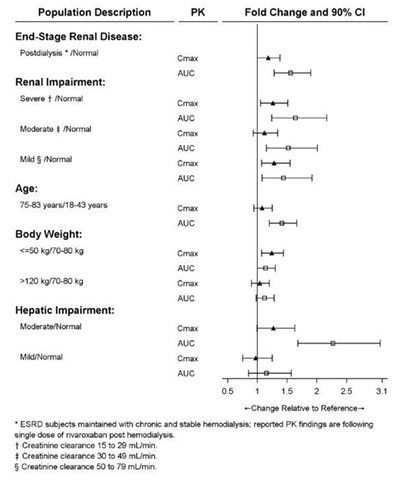
This appears to be a report or a study on the population description and pharmacokinetics (PK) of different groups of individuals with specific health conditions and demographic characteristics. It includes information related to the PK fold change and 90% confidence interval for varying demographics and conditions, such as end-stage renal disease and renal impairment, as well as age, body weight, and hepatic impairment. The report details the AUC measurements for each demographic and condition, but without further context or information, it is difficult to provide a more specific summary.*
Figure 4 - xarelto 05
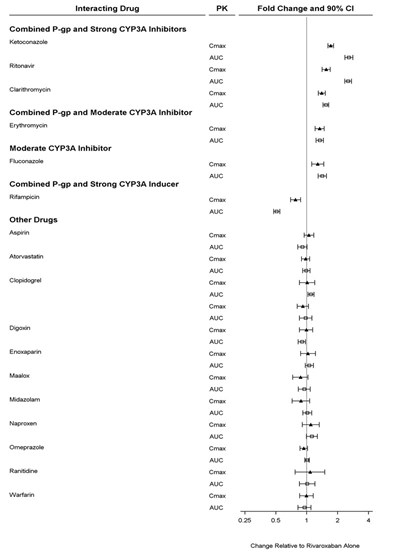
The text represents a table indicating the interactions of different drugs with specific inhibitors and inducers. The table shows the fold change in drug pharmacokinetics (PK) and the 90% confidence interval (CI) for each interaction. The drug interactions are classified into four categories: combined P-gp and strong CYP3A inhibitors, combined P-gp and moderate CYP3A inhibitor, moderate CYP3A inhibitor, and combined P-gp and strong CYP3A inducer. Additionally, the table reports the relative change of some drugs concerning Rivaroxaban alone. Therefore, this table summarizes data on drug-drug PK interactions focusing on inhibitors and inducers of P-gp and CYP3A enzymatic systems.*
Figure 5 - xarelto 06
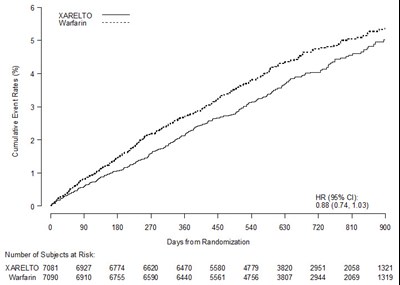
This text provides Cumulative Event Rates and the Number of Subjects at Risk for two types of anticoagulants: XARELTO and Warfarin. It also gives information on the Hazard Ratio (HR) for the two treatments as well as the Days from Randomization. However, without any additional context, it is not possible to determine the specific event being measured or the purpose of the study.*
Figure 6 - xarelto 07
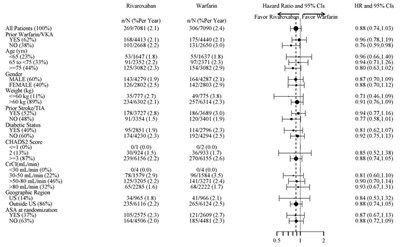
This is a table summarizing information about patients in a study comparing the medications Rivaroxaban and Warfarin. The table includes information such as patients' prior conditions (e.g. stroke, diabetes), their gender and weight, their renal function, the CHADS2 score, and whether they were randomized to receive ASA. Additionally, the table includes data regarding the efficacy of the two medications in preventing strokes, shown in hazard ratios with 95% confidence intervals.*
Figure 7 - xarelto 08
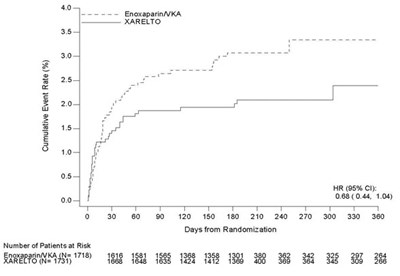
The given text is formatted as a graph representing the Cumulative Event Rate % for 2 medications (Enoxaparin VKA and Xarelto) over a period of 360 days from randomization. The number of patients at risk is also shown. A Hazard Ratio (HR) with 95% Confidence Interval is given for Xarelto compared to Enoxaparin VKA. No further contextual or informative details are provided.*
Figure 9 - xarelto 10
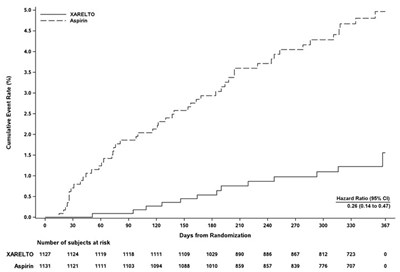
This appears to be a graph that compares two subjects, XARELTO and Aspirin, with the "Hazard Ratio" as 85% and the "Cumulative Event Rate" on the Y-axis and the days from randomization on the X-axis. There are some erratic and non-relevant characters throughout the text.*
* The product label images have been analyzed using a combination of traditional computing and machine learning techniques. It should be noted that the descriptions provided may not be entirely accurate as they are experimental in nature. Use the information in this page at your own discretion and risk.




